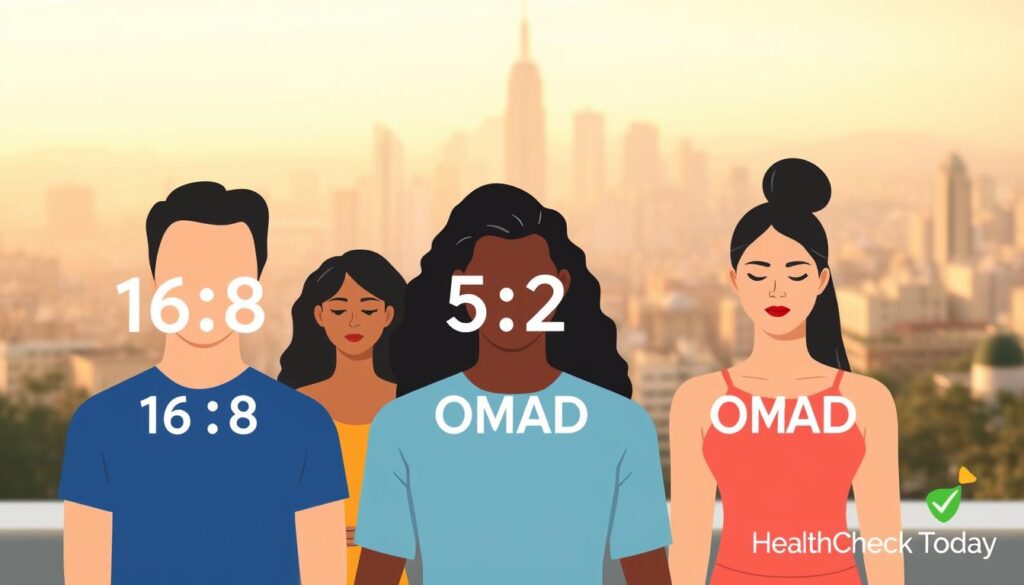
Are you thinking about trying intermittent fasting but don’t know where to begin? There are many methods and schedules to choose from. It can be hard to pick the right one for you.
Exploring intermittent fasting means more than just when you eat. It’s also about eating healthy during your eating times. If you’re looking for a guide or just want to know more, you’re in the right spot. Intermittent fasting can help with weight loss and better health.
When starting intermittent fasting, remember everyone’s experience is different. What works for one might not work for another. So, it’s key to find a schedule that fits your life and likes.
Key Takeaways
- Intermittent fasting involves alternating periods of eating and fasting to promote weight loss and improve metabolic health.
- There are various intermittent fasting methods, including the 16:8 method, 5:2 diet, and alternate-day fasting.
- It’s essential to find a schedule that works for your lifestyle and goals, whether you’re a beginner or experienced with intermittent fasting.
- A balanced diet during eating periods is crucial for overall health and weight loss.
- Intermittent fasting may have benefits for weight loss, insulin resistance, and cardiovascular health, but it’s not suitable for everyone, particularly those with certain health conditions.
- It’s recommended to start intermittent fasting gradually, with a 1-2 day per week approach, and listen to your body to avoid any adverse effects.
Understanding Intermittent Fasting and Its Role in Fat Loss
Intermittent fasting is a way to lose fat. It has many benefits and can help you manage your weight. By fasting, you can lose weight and make your body more sensitive to insulin.
Creating a meal plan for intermittent fasting is important. You need to think about what works best for you. Some people like the 16/8 method, eating in an 8-hour window. Others prefer the 5:2 diet, eating less on two days a week.
Studies show that intermittent fasting can help you lose fat. People have lost up to 13% of their weight. It also improves blood pressure and reduces inflammation.
Remember, everyone is different when trying intermittent fasting. Listen to your body and make changes if needed. With the right plan, you can see great results and feel better overall.
Popular Intermittent Fasting Methods for Maximum Results
There are many intermittent fasting for weight loss methods to try. The intermittent fasting 16/8 is very popular. You fast for 16 hours and eat in an 8-hour window. This can help with blood sugar and weight loss.
The 5:2 diet is another choice. You eat normally for 5 days and eat very little on the other 2. Alternate day fasting means fasting every other day. Pick a method that fits your life for the best results.

The intermittent fasting benefits are many. They include losing weight, better blood sugar, and more human growth hormone. But, listen to your body and change your fasting if needed. With the right method, intermittent fasting for weight loss can really help you reach your health goals.
The Best Intermittent Fasting Schedule for Your Lifestyle
Finding the right schedule for intermittent fasting is key for weight loss. Starting can seem hard, but with the right plan, you can reach your goals. Begin with a simple schedule and slowly increase your fasting times.
The 16/8 method is popular. It means fasting for 16 hours and eating for 8. You can adjust it to fit your life. For example, fast from 8 pm to 12 pm the next day.

The 5:2 protocol is another choice. You eat normally for 5 days and limit calories to 500-600 on the other 2. It’s good for weight loss and health. Alternate day fasting involves eating normally one day and restricting calories the next.
The best schedule for you depends on your needs and goals. Think about your schedule, diet, and health goals. This way, you can find the best method for you and lose weight with intermittent fasting.
| Method | Description | Benefits |
|---|---|---|
| 16/8 | Fasting for 16 hours, eating for 8 hours | Flexible, easy to follow, and can be adjusted to fit your lifestyle |
| 5:2 | Eating normally for 5 days, restricting calories to 500-600 on the other 2 days | Can be beneficial for weight loss and improving overall health |
| Alternate Day Fasting | Alternating between days of normal eating and days of calorie restriction | Can be effective for weight loss and improving insulin sensitivity |
Essential Tips for Starting Your Fasting Journey
Starting a beginners’ intermittent fasting plan means staying hydrated. It also means not thinking about food too much. And, make sure every calorie counts.
Resting and relaxing are key. They help your body get used to the new eating schedule. Eating foods that are filling but not too calorie-heavy makes fasting easier and more fun.
To get the most out of your easy intermittent fasting for beginners plan, follow these tips:
- Drink lots of water to keep hunger away and stay hydrated.
- Stay away from things that make you think about food, like cooking shows or food blogs.
- Get enough sleep and try relaxation methods like meditation or deep breathing.
- Choose foods that are filling but not too calorie-heavy, like salads or soups.
- Add herbs and spices to your meals to make them taste better without adding calories.
Remember, a successful beginners’ intermittent fasting plan is all about listening to your body. Be patient and don’t get too upset if you slip up. With time, you’ll find a fasting routine that fits you and helps you reach your health goals.

Optimizing Your Eating Window for Fat Loss
When you follow an intermittent schedule, it’s key to make the most of your eating time for fat loss. You need to find the best intermittent fasting schedule that fits your life. Then, adjust when and what you eat to get the most nutrients.
Eat foods that are full of nutrients like lean proteins, whole grains, and lots of fruits and veggies. To keep hunger away, drink lots of water and zero-calorie drinks like black coffee and tea. It’s also important to listen to your body and change your optimal fasting times if needed. Some like a 16-hour fast followed by 8 hours of eating. Others prefer a more flexible schedule.

- Plan your meals ahead to get all the nutrients you need.
- Watch your portion sizes to not eat too much during your eating time.
- Stay active and exercise often to help with weight loss.
By following these tips and finding the rightintermittent schedulefor you, you can make your eating window work for fat loss. This will help you reach your weight loss goals.
Common Mistakes to Avoid While Intermittent Fasting
When you’re on an effective fasting routine, it’s key to avoid common mistakes. Not drinking enough water is a big one. It can cause headaches and make you feel tired. Try to drink 8-10 glasses of water every day to stay hydrated.
Another mistake is ignoring your body’s signals. If you feel weak or dizzy, it’s time to change your top fasting schedule. Also, not eating enough protein can harm your muscles and slow down your metabolism.
To steer clear of these errors, here are some tips:
- Start with shorter fasting periods and gradually increase the duration
- Stay hydrated by drinking plenty of water throughout the day
- Listen to your body and adjust your fasting schedule as needed
- Eat a balanced diet with plenty of protein and healthy fats during your recommended eating window

By avoiding these mistakes and sticking to a good effective fasting routine, you can reach your weight loss goals. Always put your health first. If you’re thinking about starting a new diet or fasting plan, talk to a healthcare professional first.
Combining Exercise with Your Fasting Schedule
Creating a good intermittent fasting plan means thinking about exercise too. Adding physical activity can boost fat loss. But, it’s key to balance exercise with fasting times. This combo works well if planned right.
Working out on an empty stomach can burn more fat. Yet, listen to your body and adjust your workouts. Some find fasting boosts energy and focus, helping their workouts.

- Schedule workouts for the end of fasting to aid recovery.
- Do low-intensity activities like walking or yoga during long fasts.
- Drink lots of water and add coconut water for electrolytes.
Intermittent fasting and exercise together can be a great weight loss tool. It also boosts health and well-being. Always listen to your body and tweak your plan as needed.
Tracking Progress and Adjusting Your Protocol
Starting your intermittent fasting journey means tracking your progress and adjusting as needed. Watch your weight, body fat, and health closely. This helps you see what works for you and make smart choices about your intermittent fasting and nutrition plan.
Some people do better with a 16/8 schedule, while others like 5:2. Being patient and consistent is key. By tweaking your eating times, exercise, and diet, you can get better results and feel healthier and happier.

- Take regular weight and body fat measurements
- Monitor your overall health and energy levels
- Adjust your eating window and exercise routine as needed
Follow these steps and pay attention to your intermittent fasting and nutrition plan. This way, you can reach your goals and live a healthy, balanced life.
Conclusion: Making Intermittent Fasting Work Long-Term
Adding intermittent fasting to your life can help with fat loss and health. But, it’s important to be consistent, patient, and flexible. Everyone’s body is different, so you might need to try a few fasting schedules to find the right one for you.
If you’re new to this, talking to a registered dietitian is a good idea. They can help pick the best plan for you. They can also give tips on handling hunger, adjusting your eating times, and solving any problems you might have.
To keep going, stay committed, track your progress, and be ready to make changes if needed. With the right attitude and support, you can make intermittent fasting a lasting part of your healthy lifestyle.













